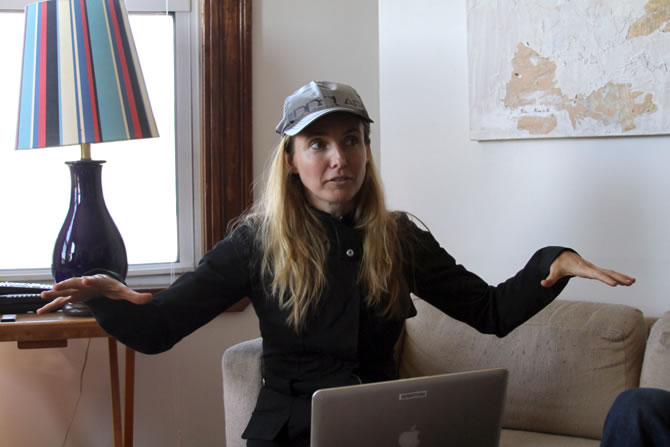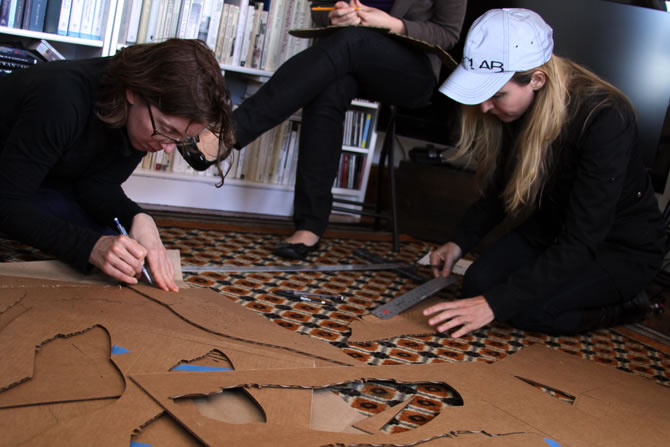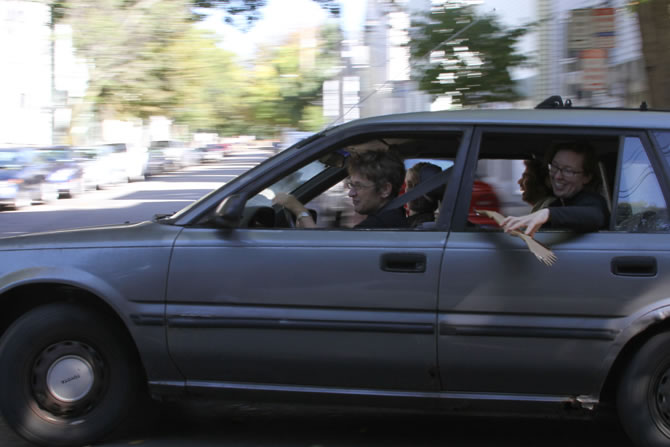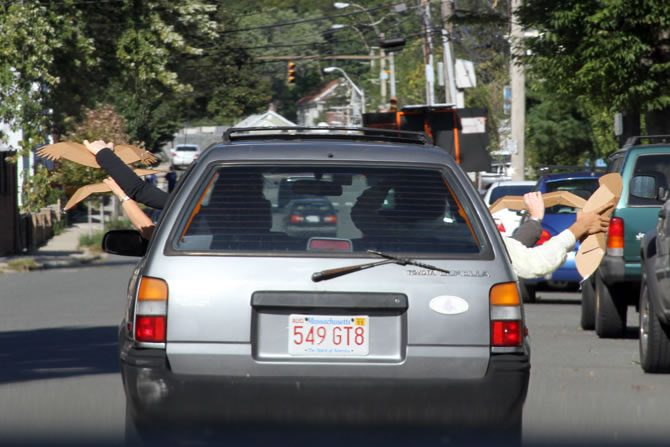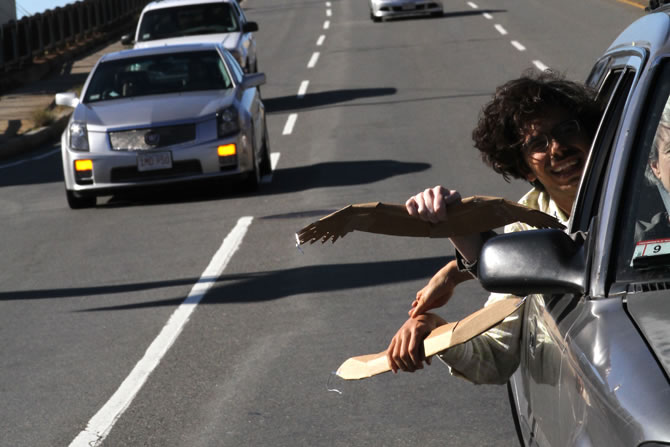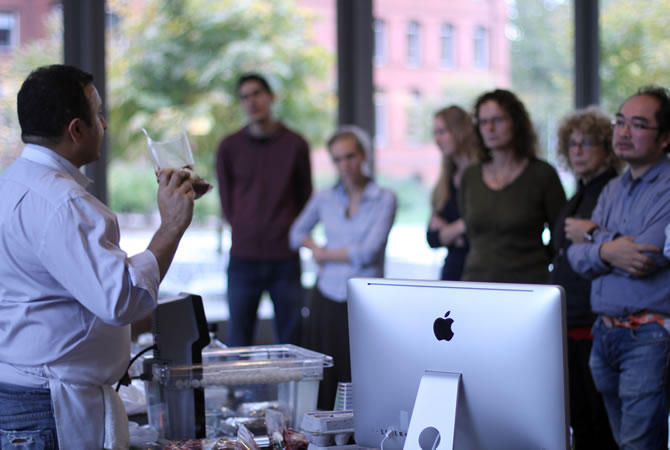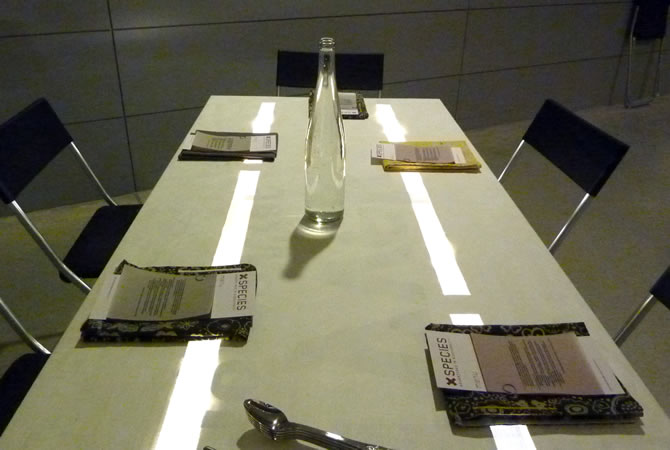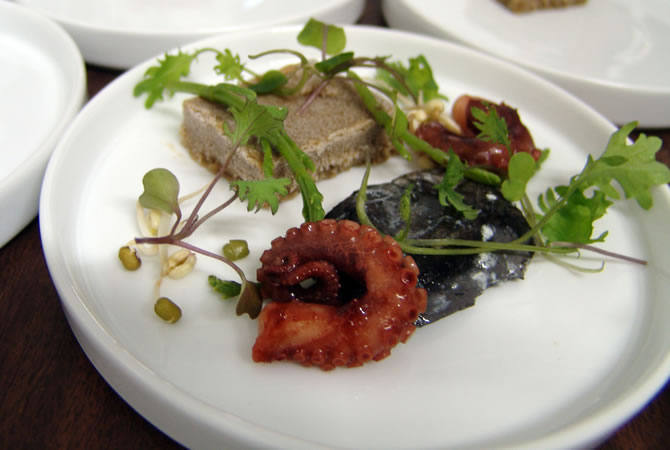Natalie Jeremijenko
Environmental Health Clinic +
Cross(x)Species Adventure Club
In 2010 and 2011, Artists in Context worked with artist/engineer Natalie Jeremijenko to plan and partially implement a Boston field office of her Environmental Health Clinic and to inaugurate a series of dinners and related workshops as a branch of her Cross(x)Species Adventure Club in Boston. Documentation from these two projects can be seen below. Natalie also plans to create an additional, special Prospectus contribution in coming months.
According to Natalie, the Environmental Health Clinic (EHC) “is an experimental design project to transform our relationship to nature; to break down the division between humans and other species and demonstrate that the world is one giant feedback loop, and that any division between self and other, society and nature, is a problematic dichotomy.” The original EHCis at New York University, where Natalie teaches, and, as she explains on the EHC website:
“The clinic works like this. You make an appointment, just like you would at a traditional health clinic, to talk about your particular environmental health concerns. What differs is that you walk out with a prescription not for pharmaceuticals but for actions: local data collection and urban interventions directed at understanding and improving your environmental health; plus referrals, not to medical specialists but to specific art, design and participatory projects, local environmental organizations and local government or civil society groups: organizations that can use the data and actions prescribed as legitimate forms of participation to promote social change.”
AIC held several planning meetings involving Natalie and/or a number of environmental, health and community activists and civic leaders in 2010 and 2011 to discuss the set-up of an EHC Field Office in Boston and in 2011 commissioned artist and designer James Schaffroth to do additional research and draw up a plan, completed in 2012, elements of which appear below. In 2010, Natalie also conducted workshops around two protocols, for AgBags and Wet Landings, that could potentially become part of a Boston EHC field office. See below for descriptions and documentation of these workshops.
According to Natalie, the Cross(x)Species Adventure Club “…is an experience of the depth and complexity of our interconnections with nonhumans, exploring the web that traces our gastronomical, economic and material interdependency with butterflies, worms, geese, bats and other intelligent and delicious creatures. The supper club will present multiple courses of foods, delicious and nutritious to both humans and nonhumans, expertly paired with delectable cocktails.
“Through wilderness adventures for your palette you can support the research behind the Cross(x)Species Adventure Club and explore food webs, community structure, chemistry, nutrient cycles and the behavior of organisms within the context of complex ecological systems. For instance, when enjoying the luxuriant creaminess of nanoWaterBuffalo Ice Cream (nano because of the size of the liquid nitrogen submerged ice crystals), you promote the producers (water buffalo) who demand reconstructed wetlands to reverse ongoing wetland loss for their own grazing and culinary preferences.”
Documentation of AIC-sponsored Cross(s)Species Adventure Club workshops and dinners, with the “water as food” dinner highlighted, appears below.
Funding for Natalie Jeremijenko’s work in Boston and for development of a plan for the Boston EHC Field Office was generously provided by the Barr Foundation.
AgBags Workshop
The AgBags prescription that formed the basis of this workshop is contained in the downloadable PDF after the workshop slideshow below.
Photos by Joe Joe Orangias (workshop in Cambridge, MA) and Marie Cieri (later AgBag installation at Socrates Sculpture Park in Queens, NY):
Wet Landings Workshop
Some of Natalie’s recent work revolves around re-imaging flight. Flight is one of the most environmentally harmful things humans do, and while Natalie says algae fuels provide incremental improvements, she wants to radically re-think human mobility. One of her ideas builds on the recent release of the Icon A5, a personal plane that can land on water/in wetlands; by landing there instead of on asphalt strips, she hopes that one day we might be able to restore these native areas that so many American airports have destroyed in favor of building runways. She wants to market “wetlanding strips” that accommodate these new planes, and this workshop involved assembling and testing out a new airplane wing shape that might assist in furthering these “wet landings” in new, environmentally helpful, locations.
Photos in slideshow below by Joe Joe Orangias
The Boston Environmental Health Clinic
Based on multiple planning meetings and James Schaffroth’s additional research, the main feature of Boston EHC Field Office would be a Mobile Health Clinic that would move around and stop in various locations around the city of Boston. Within his 2012 report and plan for the EHC, James states:
“Guiding this design of the mobile health clinic are several keywords generated at an EHC planning session which dozens attended, along with two newly introduced keywords. The existing suggestions of “morphic”, “modular”,and “mobile” have been preserved – while “simplicity” and “legibility” have been added. The Mobile Health Clinic is designed to be a human-scale construction that may be assembled without the use of hand or power tools – allowing erection of the structure to be a community building exercise itself. It’s form serves as icon, landmark, and enclosed architectural space. The office itself is located in the rear of the Clinic, while exterior and interior surfaces present information. Hidden storage space lies at the front of the Mobile Clinic, while an art-based garden exhibit visually communicating the EHC’s concept is displayed alongside.”
In order to implement the Boston Field Office and its Clinic, Artists in Context will need raise additional funding and to cultivate partnerships with environmental, scientific, health organizations and community-based organizations.
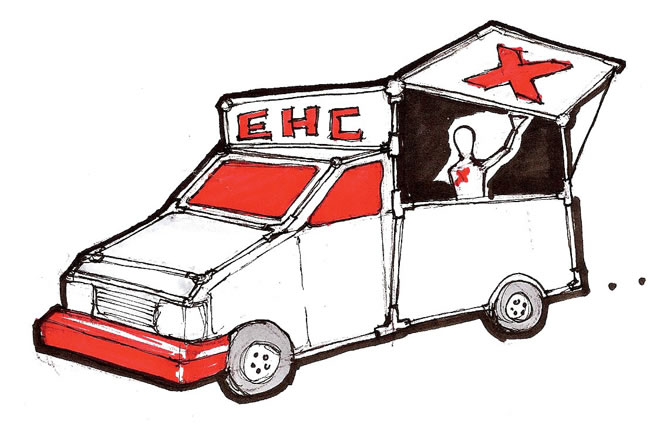
Design for the Boston Mobile Health Clinic by James Schaffroth

New Boston Field Office and Mobile Clinic logo
Cross(x)Species Adventure Club
![Natalie Jeremijenko Cross[X] Species](http://artistsincontextprospectus.org/wp-content/uploads/2013/08/Jeremijenko_CrossX_logo.jpg)
Cross(x)Species Tasting Workshop: Molecular Gastronomy and Urban Agriculture, February 15, 2011, in conjunction with talks by Natalie Jeremijenko and Matthew Mazzota on “Tactical Design and Ecology.” Media Lab, MIT, Cambridge. Co-sponsored by MIT Program in Art, Culture and Technology.
estuary: Dinner, July 27, 2011, samson projects, 450 Harrison Ave., Boston
air quality + the qualities of air: Workshop and Dinner, September 24, 2011, Rhys Gallery, 401 Harrison Ave., Boston
water as food: adventures in possible water futures Workshop and Dinner October 22, 2011, The Laboratory, Harvard University, Cambridge
The following slideshow features images from the “water as food” workshop (led by Mihir Desai) and dinner and the “estuary” dinner. Photos: The Laboratory at Harvard, Marie Cieri, Peggy Reynolds.
Featured: “water as food”: AIC organized a dinner in collaboration with The Lab at Harvard and the Cross(x)Species Adventure Club, a collaborative project by Natalie Jeremijenko and molecular gastronomist Mihir Desai. At the dinner, participants explored our collective relationship to water and our capacity to improve this through redesigning our food and food systems. In each of 5+ paired courses, diners experienced water equivalents, shadow water, green, blue and grey water… all of which quantify the water required in the various stages of the production and digestion of a particular food, ranging from lettuces to beef, to trace the complex distribution and transformation of this transparent substance of life.
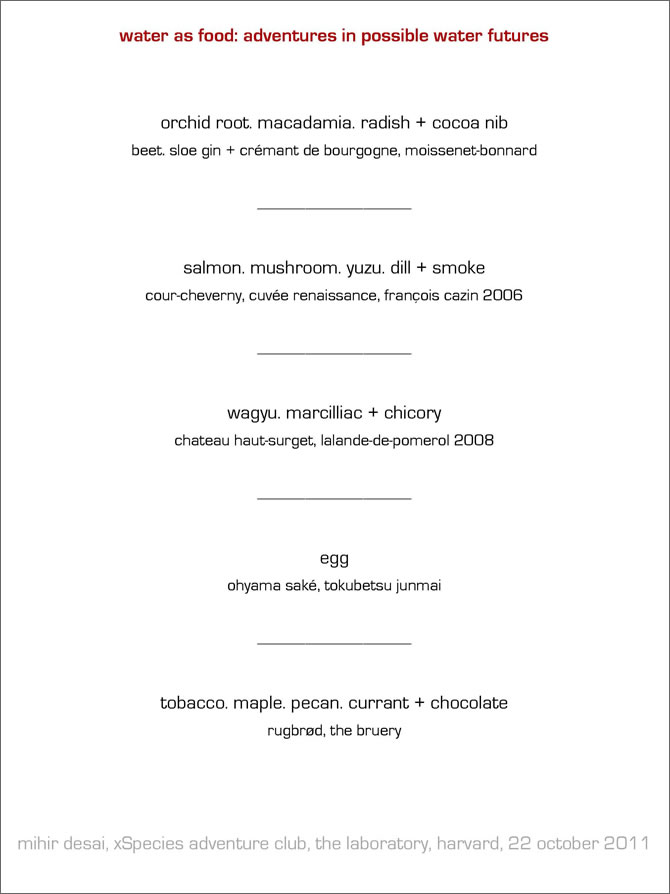
“water as food” menu, October 22, 2011
Water Bear (Tardigrade)
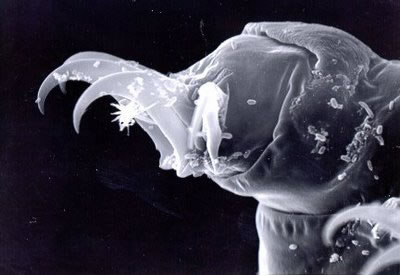 These ferocious looking bears have figured out how to survive in every continent, ocean + habitat as long as there is water. They can survive the vacuum of space + complete desiccation by shutting down all of their physiological processes for 7 years or longer through the use of spores. This creates microclimates + controls + is a strategy to create habitable, generative places in highly variable conditions. The Water Bear, an extremophile, is an organism that might teach us how to redesign our hydro-electric systems, develop distributed local power production, + even rethink agricultural systems. — NJ
These ferocious looking bears have figured out how to survive in every continent, ocean + habitat as long as there is water. They can survive the vacuum of space + complete desiccation by shutting down all of their physiological processes for 7 years or longer through the use of spores. This creates microclimates + controls + is a strategy to create habitable, generative places in highly variable conditions. The Water Bear, an extremophile, is an organism that might teach us how to redesign our hydro-electric systems, develop distributed local power production, + even rethink agricultural systems. — NJ
Kissing Frogs (a frequent offering at Cross(x)Species Adventure Club dinners)
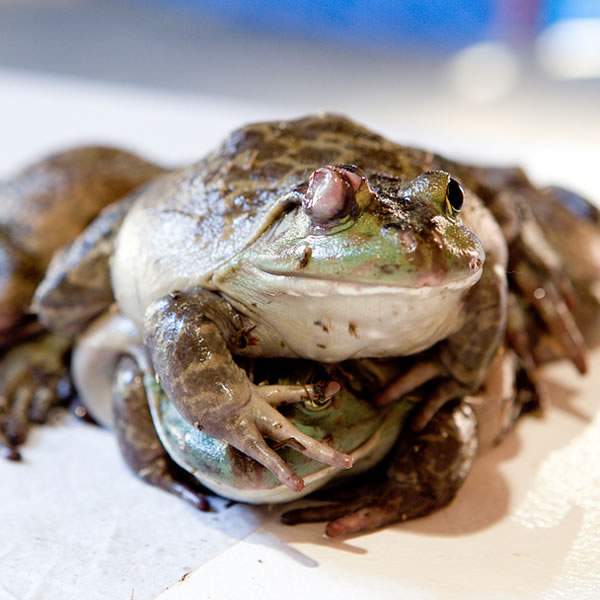 The combined effects of habitat loss, industrial pollutants and a deadly fungus distributed internationally through medical laboratory protocols for pregnancy testing have created an amphibian catastrophe that rivals in scale the dinosaur extinction event in sheer numbers of species threatened and disappeared.
The combined effects of habitat loss, industrial pollutants and a deadly fungus distributed internationally through medical laboratory protocols for pregnancy testing have created an amphibian catastrophe that rivals in scale the dinosaur extinction event in sheer numbers of species threatened and disappeared.
As many as one third of the world’s 6,260 known amphibian species are in danger of going extinct. The main killer – outside of habitat destruction – is a fungal disease known as chytrid (Batrachochytrium dendrobatidis). A mutualistic association with particular antifungal microbes, however, protects certain amphibian species from the lethal skin disease. Janthinobacterium lividum is a bacterium that produces the anti-B. dendrobatidis metabolite violacein, an intensely violent pigment. To inoculate a local frog population, imbibe some cocktail marshmallows + pucker up. — NJ
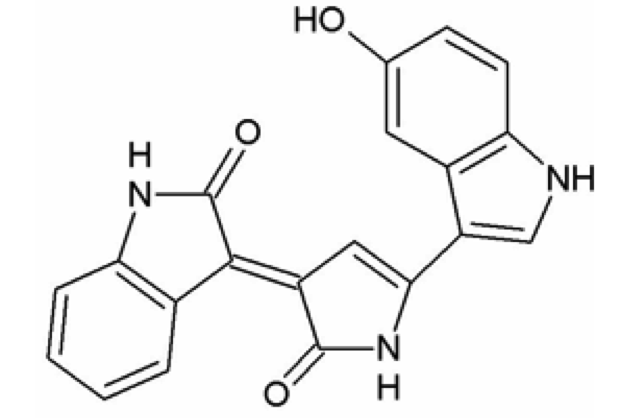
[violacein]
 Natalie Jeremijenko is an innovative artist and engineer whose background includes studies in biochemistry, physics, neuroscience, and precision engineering. Named one of the inaugural top young innovators by MIT Technology Review and one of the Top 40 most influential designers by I.D. Magazine, Natalie directs the experimental (xDesign) Environmental Health Clinic at New York University, where she is an Associate Professor in the Visual Art Department and is affiliated with the Computer Science Department and the Environmental Studies program. Previously she was on the Visual Arts faculty at UCSD and the Faculty of Engineering at Yale University. She came to NYU as a Global Distinguished Professor, was recently a visiting professor at Royal College of Art in London and was a Distinguished Visiting Professor in the Public Understanding of Science at Michigan State University.
Natalie Jeremijenko is an innovative artist and engineer whose background includes studies in biochemistry, physics, neuroscience, and precision engineering. Named one of the inaugural top young innovators by MIT Technology Review and one of the Top 40 most influential designers by I.D. Magazine, Natalie directs the experimental (xDesign) Environmental Health Clinic at New York University, where she is an Associate Professor in the Visual Art Department and is affiliated with the Computer Science Department and the Environmental Studies program. Previously she was on the Visual Arts faculty at UCSD and the Faculty of Engineering at Yale University. She came to NYU as a Global Distinguished Professor, was recently a visiting professor at Royal College of Art in London and was a Distinguished Visiting Professor in the Public Understanding of Science at Michigan State University.
Her work was included in the 2006 Whitney Biennial of American Art (also in 1997) and the Cooper Hewitt Smithsonian Design Triennial 2006-2007. In 2010 the Neuberger Museum produced a solo exhibition surveying her recent work, entitled Connected Environments, and another solo exhibition entitled X was shown the same year at the University of Technology, Sydney. Recent group exhibitions in which her work has been seen are: Alter Nature: Designing Nature – Designing Human Life – Owning Life at Z33 in Hasselt; EXPOSED Voyeurism, Surveillance, and the Camera Since 1870 at SFMOMA/TATE Modern; Certified Copy at the Verbeke Foundation, Belgium; Eat Me! at Postmasters Gallery, New York, NY (Re)designing Nature.(Re)designing Nature at Kuenstlerhaus, Vienna; the Mortality exhibition at the Australian Center for Contemporary Art, Melbourne; and Civic Action: A Vision for Long Island City at the Noguchi Museum and Socrates Sculpture Park in Queens, NY.
Jeremijenko Work with Mussels on View in NYC through Aug. 2






